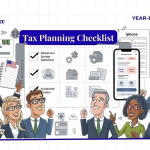Introduction: Why Capital Gains Tax Matters for Investors
Did you know how long you hold an investment can mean the difference between paying 0% or 37% in taxes? The capital gains tax significantly impacts investment returns, yet many Americans don’t fully understand how it works.
This guide will break down:
- What capital gains are(and when you owe taxes)
- Short-term vs. long-term tax rates(2024-2025 IRS brackets)
- How to use capital lossesto reduce your tax bill
- Smart strategiesto legally minimize what you owe
Let’s dive in.
1. What Is a Capital Gain?

A capital gain occurs when you sell an asset for more than youradjusted basis(typically what you paid plus improvements). The taxable amount is the difference between your sale price and basis.
- Purchase price (cost basis)
- Sale price
- Holding period(short-term vs. long-term)
Example:
- You buy **10 shares of Amazon at 100∗∗(100∗∗(1,000 total).
- Sell them later for **150 per share∗∗(150 per share∗∗(1,500 total).
- Your **capital gain = 500∗∗(500∗∗(1,500 – $1,000).
Key Insight:
- Unrealized gains(still holding the asset) →No tax
- Realized gains(after selling) →Taxable
Know more about Capital Gains: What Are They and How Are They Taxed?
2. Short-Term vs. Long-Term Capital Gains: The 1-Year Rule

The IRS taxes gains differently based onhow long you hold the assetbefore selling:
| Factor | Short-Term Capital Gains (≤1 Year) | Long-Term Capital Gains (>1 Year) |
| Tax Rate | Same as ordinary income (10%-37%) | Lower rates (0%, 15%, or 20%) |
| Best For | Day traders, short-term flips | Buy-and-hold investors |
| NIIT Surcharge | Yes (if income over $200k) | Yes (if income over $200k) |
Real-Life Example:
- Short-term:Sell Tesla stock after6 months→ Pay24% tax(or higher).
- Long-term:Sell after1 year + 1 day→ Pay15% tax(or0%if income is low).
Why This Matters:
Holding an assetjust one extra daycan save youthousands in taxes.
3. Short-Term Capital Gains Tax Rates (2024-2025)

Short-term gains are taxed atordinary income rates—the same as your salary or wages.
2024 Short-Term Capital Gains Tax Rates (Filing in 2025)
| Single Filers | Married Filing Jointly | Tax Rate |
| 0−0−11,600 | 0−0−23,200 | 10% |
| 11,601−11,601−47,150 | 23,201−23,201−94,300 | 12% |
| 47,151−47,151−100,525 | 94,301−94,301−201,050 | 22% |
| Up to $609,350 | Up to $731,200 | 37% |
2025 Short-Term Capital Gains Tax Rates (Filing in 2026)
- Expect~5% inflation adjustments(exact IRS numbers TBD).
Key Takeaway:Short-term gains canpush you into a higher tax bracket, increasing your overall tax bill.
*Estimated based on inflation adjustments perTax Policy Centerdata
4. Long-Term Capital Gains Tax Rates (2024-2025)

The IRS rewardslong-term investorswith lower tax rates:
2024 Long-Term Capital Gains Tax Rates (Filing in 2025)
| Single Filers | Married Filing Jointly | Tax Rate |
| 0−0−47,025 | 0−0−94,050 | 0% |
| 47,026−47,026−518,900 | 94,051−94,051−583,750 | 15% |
| Over $518,900 | Over $583,750 | 20% |
2025 Long-Term Capital Gains Tax Rates (Filing in 2026)
- Similar brackets, adjusted for inflation.
Pro Tip:If your income isjust above the 0% bracket, considerselling in chunksto stay under the limit.
5. The 3.8% Net Investment Income Tax (NIIT) Surcharge

If yourModified Adjusted Gross Income (MAGI)exceeds:
- $200,000 (Single)
- $250,000 (Married Filing Jointly)
You’ll pay anextra 3.8%on capital gains.
Example:
- Single filer with220,000income+220,000income+50,000 long-term gains
- Pays15%(7,500)+∗∗3.87,500)+∗∗3.820,000** (760)→∗∗Totaltax:760)→∗∗Totaltax:8,260**
6. Capital Gains in Retirement Accounts (401(k), IRA, Roth IRA)

Different accounts havedifferent tax rulesfor capital gains:
| Account Type | Capital Gains Tax Treatment |
| Traditional 401(k)/IRA | Tax-deferred (pay ordinary income tax at withdrawal) |
| Roth IRA | Tax-free growth(no capital gains tax if rules followed) |
| Taxable Brokerage | Standard capital gains tax rules apply |
Best Strategy:
- Holdhigh-growth stocksinRoth IRAs(tax-free forever).
- Keepbonds/dividend stocksintax-deferred accounts.
7. How Capital Losses Can Reduce Your Tax Bill
The IRS lets youuse investment losses to offset gains:
- Same-year offsetting:Short-term losses first reduce short-term gains.
- $3,000 deduction:Excess losses can reduce ordinary income.
- Carryforward:Unused losses roll over indefinitely.
Example:
- $10,000 short-term gain
- $4,000 short-term loss
- 3,000long−termloss∗∗→∗∗Nettaxablegain:3,000long−termloss∗∗→∗∗Nettaxablegain:3,000(instead of $10,000).
8. 5 Smart Ways to Minimize Capital Gains Taxes

1. Hold Investments >1 Year
- Convert37% short-term tax → 15% or 0% long-term rate.
2. Tax-Loss Harvesting
- Offset gains with investment losses (up to $3,000/year excess can be deducted against income)
3. Use Retirement Accounts
- Roth IRAs =no capital gains tax ever.
4. Gift Appreciated Stock
- Donate to charity →avoid gains + get a deduction.
5. Time Sales in Low-Income Years
- Retirees can oftenpay 0%on long-term gains.
You can read this article for details – Capital Gains Tax Simplified: Short-Term vs. Long-Term & Ways to Reduce Your Tax Bill
9. FAQs (What Real Investors Ask)

Q1: Does the 1-year rule apply to cryptocurrency?
✅Yes!Crypto follows the same rules as stocks.
Q2: What if I sell my home?
- 250k(single)/250k(single)/500k (married) exclusionif lived there2 of last 5 years.
Q3: Are there states with no capital gains tax?
- Yes!Texas, Florida, Nevada, and 6 others have0% state capital gains tax.
Q4. Do I Owe Capital Gains Tax If I Reinvest My Profits?
✅ Yes! Reinvesting profits (e.g., using stock sale proceeds to buy another stock) doesn’t avoid taxes. The IRS still treats the sale as a realized gain, so you’ll owe tax in the year you sold the asset. The only way to defer taxes is by using retirement accounts (like a 401(k) or IRA) or a 1031 exchange (for real estate).
Q5. Can I Avoid Capital Gains Tax by Moving to a No-Tax State?
🚩 It depends. While states like Florida and Texas have no state capital gains tax, the IRS still enforces federal taxes. To fully escape state tax, you must:
- Establish residency in the new state (e.g., change driver’s license, voter registration).
- Spend most of the year there (many states require 183+ days).
Warning: High-tax states (e.g., California, New York) may still tax you if they consider you a “part-year resident.”
Final FAQ Bonus: What’s the “Wash Sale Rule”?
🚫 Don’t get penalized! The IRS disallows the loss if you sell a stock at a loss and rebuy it (or a “substantially identical” asset) within 30 days. This applies to stocks, crypto, and options.
Workaround: Wait 31+ days to repurchase, or buy a similar (but not identical) asset (e.g., swap SPY for VOO).
Read this article, provided by the IRS: Topic no. 409, Capital gains and losses
Final Takeaways: How to Keep More of Your Profits
- Track holding periods(1 extra day can save thousands).
- Use tax-loss harvestingto offset gains.
- Maximize retirement accounts(Roth IRAs = best for growth).
- Consult a tax profor complex situations.
Want More?Bookmark this guide and revisit before selling investments!
Now go invest smarter—and keep more of your money!🚀
Thank you for reading this post, don't forget to subscribe!







https://myteana.ru/forums/index.php?autocom=gallery&req=si&img=6606